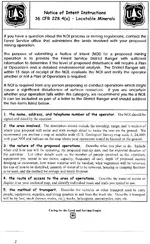BLM surface management program for
locatable mineral operations on BLM-administered lands. The purpose of the Proposed Action is to adopt regulations that would address issues that have developed since BLM’s surface management program for
locatable mineral operations began in 1981 and to improve BLM’s management of
locatable mineral activities on the public lands.
Notice-Level operations use mechanized earth-moving equipment and disturb 5 acres or less.
A
Plan of Operations is required when mining or exploration would
disturb more than 5 acres or for any surface disturbance in BLM’s special status areas. Since approval of a
Plan of Operations is a federal action, an environmental assessment (EA) or environmental impact statement (EIS) must be prepared.
Spells it out fairly clear. Appears that the "Locatable mineral operations" can only be in acres units. Very interesting don't you think so?
These OSHA regulations provide for how material handling equipment is to be used on the jobsite. A summary of the regulations follow:
https://zacherlaw.wordpress.com/osha-regulations-motor-vehicles-mechanized-equipment/
These rules apply to the following types of earthmoving equipment: scrapers, loaders, crawler or wheel tractors, bulldozers, off-highway trucks, graders, agricultural and industrial tractors, and similar equipment.
Seat Belts. Seat belts must be provided on all equipment covered by the above paragraph and are required to meet the requirements of the Society of Automotive Engineers. They need not be provided for equipment that is designed only for standup operation, nor for equipment which does not have roll-over protective structure (ROPS) or adequate canopy protection.
Access Roadways and Grades. For permissible use, access roadways or grades must be constructed and maintained to accommodate safely the movement of the equipment and vehicles involved. Every emergency access ramp and berm used by an employer must be constructed to restrain and control runaway vehicles.
Brakes. All earthmoving equipment must have a service braking system capable of stopping and holding the equipment fully loaded, as specified by the Society of Automotive Engineers. Brake systems for self-propelled rubber-tired off-highway equipment manufactured after January 1, 1972 is required to meet the applicable minimum performance criteria set forth in the Society of Automotive Engineers Recommended Practices.
Fenders. Pneumatic-tired, earth-moving haulage equipment (trucks, scrapers, tractors, and trailing units) whose maximum speed exceeds 15 miles per hour, must be equipped with fenders on all wheels to meet the requirements of Society of Automotive Engineers. (An employer may, of course, at any time seek to show that the uncovered wheels present no hazard to personnel from flying materials).
Audible Alarms. All bidirectional machines, such as rollers, compacters, front-end loaders, bulldozers, and similar equipment, require a horn that is maintained in an operative condition, is distinguishable from the surrounding noise level, and can be operated as needed when the machine is moving in either direction. Earthmoving or compacting equipment with an obstructed rear view cannot be used in reverse gear unless the equipment has in operation a reverse signal alarm distinguishable from the surrounding noise level or an employee signals that it is safe to do so.
Scissor Points. Scissor points on all front-end loaders constitute a hazard to the operator during normal operation and shall be guarded.
Lifting and Hauling Equipment.
• Lift trucks, stackers, etc., shall have the rated capacity clearly posted on the vehicle so as to be clearly visible to the operator. These ratings shall not be exceeded.
• No modifications or additions which affect the capacity or safe operation of the equipment shall be made without the manufacturer’s written approval. If such modifications or changes are made, the capacity, operation, and maintenance instruction plates, tags, or decals shall be changed accordingly. In no case shall the original safety factor of the equipment be reduced.
• If a load is lifted by two or more trucks working in unison, the proportion of the total load carried by any one truck shall not exceed its capacity.
• Steering or spinner knobs shall not be attached to the steering wheel unless the steering mechanism is of a type that prevents road reactions from causing the steering handwheel to spin. The steering knob shall be mounted within the periphery of the wheel.
• All high lift rider industrial trucks shall be equipped with overhead guards which meet the configuration and structural requirements as defined in paragraph 421 of American National Standards Institute B56.1-1969, Safety Standards for Powered Industrial Trucks.
• All industrial trucks in use shall meet the applicable requirements of design, construction, stability, inspection, testing, maintenance, and operation, as defined in American National Standards Institute B56.1-1969, Safety Standards for Powered Industrial Trucks.
• Unauthorized personnel shall not be permitted to ride on powered industrial trucks. A safe place to ride shall be provided where riding of trucks is authorized.
• Whenever a truck is equipped with vertical only, or vertical and horizontal controls elevatable with the lifting carriage or forks for lifting personnel, the following additional precautions shall be taken for the protection of personnel being elevated:
Use of a safety platform firmly secured to the lifting carriage and/or forks.
Means shall be provided whereby personnel on the platform can shut off power to the truck.
Such protection from falling objects as indicated necessary by the operating conditions shall be provided.
Site Clearing[4]
These OSHA regulations show how site clearing is to be done at the jobsite. A summary of the regulations follow:
• Employees engaged in site clearing must be protected from hazards and toxic plants and suitably instructed in the available first aid treatment.
• Equipment used in site clearing must have rollover guards; and rider-operator equipment must have overhead and rear canopy guards that meet the following requirements: First, the overhead covering must not be less than 1/8-inch plate or ¼-inch woven wire mesh with openings no greater than 1-inch. Second, the rear canopy opening must be covered with a minimum ¼-inch woven wire mesh with openings no greater than 1 inch.








